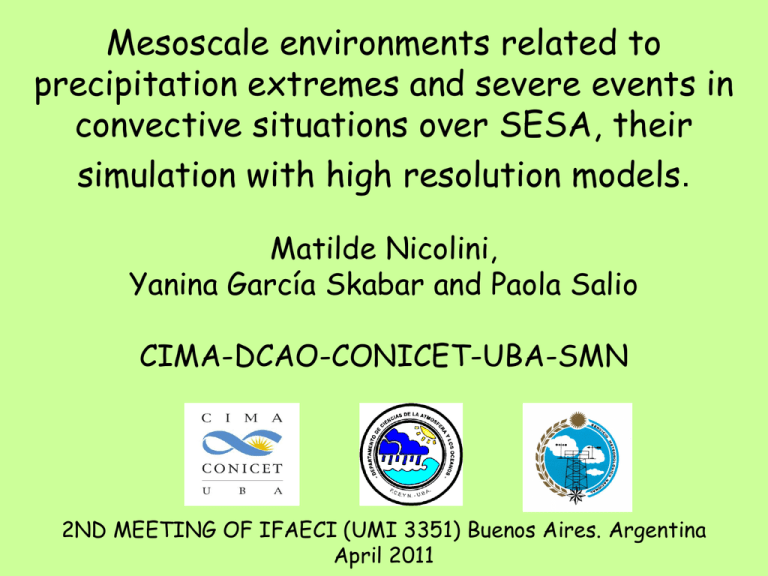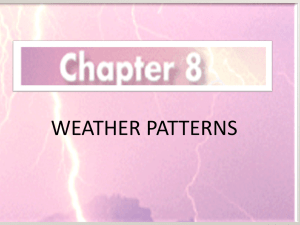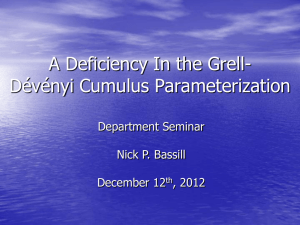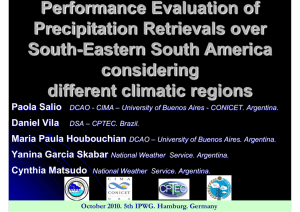Mesoscale environments related to precipitation extremes and
advertisement

Mesoscale environments related to precipitation extremes and severe events in convective situations over SESA, their simulation with high resolution models. Matilde Nicolini, Yanina García Skabar and Paola Salio CIMA-DCAO-CONICET-UBA-SMN 2ND MEETING OF IFAECI (UMI 3351) Buenos Aires. Argentina April 2011 Current Objectives: • investigate the mechanisms controlling deep moist convection in the north-central domain of Argentina and to focus on short range prediction of these mechanisms. • improve short range mesoscale numerical prediction with emphasis in different forcings of convection, from two different strategies: an explicit deterministic prediction of convection with high resolution and an ensemble forecast that allows a probabilistic approach. OUTLINE Diurnal cycle in convergence patterns in the boundary layer east of the Andes and convection Discussion of the BRAMS simulation of a flashflood convective event Discussion of the BRAMS forecast performance and sensitivity experiments in a squall line event Present and Future work Diurnal cycle in convergence patterns in the boundary layer east of the Andes and convection Purpose To progress in the study of the mechanisms that control the diurnal cycle of precipitation and convection in subtropical latitudes east of the Andes during summer Hypothesis If nocturnal convergence in the boundary layer exists over the broad valleys east of the Andes then it may be efficient in triggering or intensifying deep moist convection that may have started earlier during the afternoon if moisture is available and conditional instability prevails-. Methodology: SALLJEX was performed in Southeastern South America from November 15, 2002 to February 15, 2003 to monitor, quantify and analyze the low-level circulation over this region and its related precipitation. Enriched analyses were generated ingesting all available data with a higher spatial and temporal resolution than that available for the region, following a downscaling methodology, using Brazilian Regional Atmospheric Modeling System (BRAMS, www.brams.cptec.inpe.br). 20 km 80 km BRAMS was applied to obtain analysis every three hours, with a horizontal resolution of 80 km covering mostly South America and an enhanced inner domain with 20 km resolution for the region encompassing Central and Northern Argentina, southern Brazil, Bolivia, Paraguay and Uruguay To identify the convective systems and their life cycle IR brightness temperature data was employed at half hourly intervals with a horizontal resolution of 4km over the area between 10ºS-40ºS and 40ºW- 75ºW, data online at http://lake.nascom.nasa.gov/). The present study is organized around a two weeks long period (since January 24 up to February 7/2003) during SALLJEX that followed a cold incursion and during which different environmental conditions prevailed. Questions: ¿Are the 20 km resolution enriched analyses with SALLJEX data capable to reproduce a diurnal cycle of convergence/divergence and rising/subsiding motions at the top of the boundary layer, that may be related to a northwestern mountains-central plain flow regime? and ¿To which extent these circulations are sufficient by themselves to support deep convection or else other ABL circulation patterns as the east of the Andes lowlevel jet are more effective depending on the synoptic situation? The study period was characterized by two different main synoptic conditions: January 24 to 30: persistent anticyclonic circulation (intensified South Atlantic Convergence Zone, SACZ) and a quasi-stationary front at the southern border of the domain. Subsidence and diabatic warming in the subtropical boundary layer favored relatively dry conditions over central Argentina. January 31 to February 7: extreme heat wave with a weak SACZ and the presence of an intense thermal low over northwestern Argentina enhancing a northerly flow and coherently the presence of the east of the Andes low-level jet (SALLJ). Warm and moist horizontal advection dominated over Argentina. Anticyclonic situation SALLJ dominated situation During anticyclonic conditions Average ABL conv/div in the area shows that mesoscale zonal circulations (mountain/broad plain) dominate over meridional circulations in the average total convergence values at night and divergence dominates in the afternoon. Moisture and/or zonal convergence are not enough to support both nocturnal and daytime convection over the northern plains. Southward (35S), convection is triggered in the evening and intensified at night forced by a quasi-stationary frontal zone (not shown in the figures). During strong and shifted to the south SALLJ Average ABL conv/div in the area shows that meridional circulation (more efficient to advect moisture) dominates (over zonal circulations) convergence values at night while zonal circulation dominates the divergence in the afternoon over the plains. Higher moisture values during this period and convergence related to a propagating frontal zone are efficient to trigger convection in the afternoon at 35S (even if mean zonal divergence dominates in the area). It propagates northward and intensifies during night in a domain dominated by meridional convergence related to the SALLJ. Both the patterns of divergence related to ABL mesoscale circulations and deep convection present a nocturnal phase in their diurnal cycles. Mesoscale circulations are altered once deep convective circulations dominate over the plains. 0,1 0,08 0,06 Mesoscale circulations east of the Andes 0,04 0,02 0 -0,02 -0,04 -0,06 a) 24 25 26 27 28 29 30 31 1 2 3 4 5 6 7 0,08 0,06 Div. Total 09 UTC Div. Zonal Div. Merid. 0,04 0,02 Mountain-plain breeze Diurnal cycle 0 -0,02 -0,04 -0,06 -0,08 -0,1 b) 24 25 26 27 28 29 30 31 1 2 3 4 5 6 7 0,1 21 UTC 0,08 0,06 Nicolini, M., Garcia Skabar, Y., (2010) 0,04 0,02 0 -0,02 -0,04 -0,06 Div. Total Div. Zonal Div. Merid. -0,08 c) 24 25 26 27 28 29 30 31 1 2 3 4 5 6 7 BRAMS SIMULATION OF AN INTENSE FLOOD EVENT OVER CENTRAL ARGENTINA Methodology: BRAMS 3.2 Brazilian Regional Atmospheric Modeling System version 3.2 Simulation period : March 2007 from 25 to 31 at 12UTC Two-way grid interactive nesting technique Number of atmospheric levels: 30; vertical cordinate: shaved eta Horizontal Resolution: Grid 1 - 50 km Grid 2 - 12.5 km, Grid 3 - 3.125 km GDAS analyses from NOAA/NCEP as initial and boundary conditions. Model includes topography data (1km resolution) terrain land use (1km resolution), soil types (50km resolution), weekly sea surface temperatures daily soil moisture heterogeneous fields from USP/CPTEC Parameterizations: Shallow cumulus:Sousa and Silva; Deep convection: Grell; Explicit convection on Grid 2 and 3 Radiative: Chen and Cotton; Horizontal diffusion:Smagorinsky; Vertical diffusion: Mellor-Yamada; Microphysics: 8 water species, bulk water scheme Purpose: To describe the synoptic and mesoscale environment with particular emphasis in the relationship convective precipitation/ LLJ. To evaluate BRAMS performance in simulating an extreme rainfall situation 800 -30 MONTE CASEROS AERO Monte Caseros 700 CONCORDIA AERO Sauce Viejo Concordia SAUCE VIEJO AERO PARANA AERO PARANA INTA -32 600 Paraná EL TREBOL El Trebol ROSARIO AERO Rosario 500 GUALEGUAYCHU AERO Gualeguaychú -34 400 Junín Buenos Aires SAN FERNANDO JUNIN AERO SAN MIGUEL AEROPARQUE BUENOS AIRES BUENOS AIRES EL PALOMAR AERO CASTELAR MORON AERO INTA Ezeiza 300 -62 -60 EZEIZA AERO -58 200 Observed Grid 3 Grid 2 CMORPH AEROPARQUE BUENOS AIRES JUNIN AERO GUALEGUAYCHU AERO ROSARIO AERO EL TREBOL CONCORDIA AERO MONTE CASEROS AERO 0 PARANA AERO 100 SAUCE VIEJO AERO Observed precipitation over central Argentina, CMORPH (blue) and models forecast by (red and yellow) different grids accumulated between March 26 to 31, 2007. Grid 2 represents the precipitation forecast for 12.5 km and Grid 3 for 3.125 km respectively. -56 Synoptic Forcing Meridional wind at 30S 200 hPa Streamlines and wind intensity Equivalent potential temperature Vertically Integrated Moisture flux and its convergence 0 Rosario Buenos Aires Salta 0Z1APR2007 12Z31MAR2007 0Z31MAR2007 12Z30MAR2007 0Z30MAR2007 12Z29MAR2007 0Z29MAR2007 12Z28MAR2007 0Z28MAR2007 12Z27MAR2007 0Z27MAR2007 12Z26MAR2007 0Z26MAR2007 12Z25MAR2007 0Z25MAR2007 12Z24MAR2007 0Z24MAR2007 12Z23MAR2007 0Z23MAR2007 12Z22MAR2007 0Z22MAR2007 12Z21MAR2007 0Z21MAR2007 Temporal Evolution of GPS-Precipitable water 70 60 50 40 30 20 10 Convective and Stratiform Precipitation estimated by the CMORPH and IR area and the relationship with the LLJ 90000 10 B 80000 C A 5 70000 60000 0 50000 -5 40000 30000 -10 20000 -15 10000 12Z31MAR2007 00Z31MAR2007 12Z30MAR2007 00Z30MAR2007 12Z29MAR2007 00Z29MAR2007 12Z28MAR2007 00Z28MAR2007 12Z27MAR2007 00Z27MAR2007 12Z26MAR2007 00Z26MAR2007 -20 12Z25MAR2007 0 Stratiform and convective estimated precipitation for all systems that affect the central region of Argentina between March 25 to April 1, 2007 (green and purple). Meridional wind at 30ºS averaged between 63 and 58ºW and its ageostrophic component (pink and blue respectively) calculated from grid 3. PERFORMANCE AND SENSITIVITY STUDY OF BRAMS FORECAST Purpose To progress in the forecast of MCS events and specifically to evaluate the performance of BRAMS forecast and study the sensitivity to different initial conditions, horizontal and vertical resolution and settings on cloud microphysics scheme in a prefrontal squall line event. Case study: During early morning of January 12, 2010 an extended convective line developed in association with a cold front that propagated over the central and northern part of Buenos Aires Province, Argentina. Methodology: • 12 Numerical forecasts of the case study were performed using the Brazilian model Regional Atmospheric Modeling System (BRAMS), reaching a horizontal resolution of around 2km, using different initial conditions, horizontal and vertical resolution and settings on cloud microphysics scheme. • Model forecast performance was evaluated against measurements from radar, disdrometer, CMORPH estimations (8km-30min) and surface observations. •ETA-SMN forecast initialized 11 January at 12UTC was used as initial and boundary conditions. •Convection parameterizations is turned off in 8 and 2 km resolution •Microphysics parameterizations with 8 water species and bulk water scheme following Walko et al, 1995. •Current experimental forecast BRAMS 4.2 setting at National Weather Service •50 vertical levels (20 m near surface) •Model forecast performed for 18 hours, from 18 UTC to 12 UTC of next day initialized with a 6 hours ETA model forecast •Both mixing ratio and number concentration species are predicted Comparison against radar data squall line reflectivity evolution at 3 KM. Ensemble Forecasts FCST 07 CAPPI Ezeiza Radar All forecasts present a squall line reflectivity pattern similar to radar observations but forecasts depict larger reflectivity values, compared with Ezeiza radar that has a tendency to underestimation. Comparison against CMORPH estimations 8KM 30 min resolution Area with accumulated precipitation >15mm/30min Ensemble 6000 Ens-desv Ens-desv CMORPH FCST07 5000 3000 2000 1000 Hour UTC 0 11 :3 0 10 :3 0 09 :3 0 08 :3 0 07 :3 0 06 :3 0 :3 0 05 :3 0 04 :3 0 03 :3 0 02 :3 01 :3 0 0 00 KM2 4000 Comparison against disdrometer accumulative Precipitation 10 min 10 min accumulated precipitation in Castelar 12 Ensemble Ens-desv Ens+desv FCST07 Disdrometer 10 mm 8 6 4 2 Hour UTC 0 :0 12 0 :3 11 0 :0 11 0 :3 10 0 :0 10 0 :3 09 0 :0 09 0 :3 08 0 :0 08 0 :3 07 0 :0 07 0 :3 06 0 :0 06 0 :3 05 05 :0 0 0 Surface automatic stations Pergamino San Pedro 2m Temperature 2m Temperature 10min acc. Precipitation 10min acc. Precipitation Wind Speed 10m Wind Speed 10m Obs FCST07 Ensemble Boedo-Bs.As. Ongoing research… Case studies approach • Evaluate the performance of the model in capturing the forcing mechanisms in different scales that determine the timing, location, convective mode and propagational characteristics in different case studies, with emphasis in extreme cases. • Some cases may be strongly forced by synoptic features like the example of the pre-frontal squall line but others may be controled by contrasts in surface physiography (topography, vegetation, soil moisture) or by storms-generated outflow boundaries. Challenges • It is essential to advance on Radar calibration and improve reflectivity estimation from forecast variables, using algorithms that include mixing ratio as well as number concentration for the different microphysical species. • Also to develop an objective and appropiate methodology to validate high resolution forecasts. • There are observational demands for increased mesoscale data (raingauge and conventional surface stations, rawinsonde, Doppler radars) over Argentina for future improvement of high resolution models. • Parameterization of planetary boundary layer and microphysical processes need further testing given their control in convection initiation and evolution Some questions to be answered: • Is the genesis of convection related to topographical features such as convergence zones or mountain/plains solenoids?→accurate representation of topography and of surface characteristics? • Is the spacing of 2 km small enough to resolve: convection, LLJ strength, timing and location? • Is the model accurately initialized with soil moisture contrasts that may favor formation of drylines and therefore cloud development during early stages of the simulation? • Does higher resolution lead to greater skill of convective characteristics and of quantitative precipitation forecast? • Is there any improvement in the prediction of precipitation at the exit region of the LLJ and their diurnal cycle respect to regional models? CHUVA Project Leader: Luiz Agusto Toledo Machado Experiments Sites for the field campaign New experiment at Foz de Iguazu From 10-2012 to 1-2013 Cloud processes of tHe main precipitation systems in Brazil: A contribUtion to cloud resolVing modeling and to the GPM (GlobAl Precipitation Measurement) Scientific questions: • How to estimate rainfall from warm and deep clouds? • What is the contribution of rain from warm clouds to the total precipitation in different regions of Brazil? • How to improve both space and time precipitation estimation of rainfall over the continent for the GPM constellation? • What are the average characteristics (3D - cloud processes) of the main regimes of precipitation in Brazil? • What is the contribution of the aerosol in the process of formation of precipitation? • What are the main surface and boundary layer processes in the formation and maintenance of clouds? • How cloud microphysics and electrification processes evolves during the cloud life cycle? • How to improve precipitation estimation and cloud microphysics description by using conventional and polarimetric radar? • • • • • • • • • • • • • • • • • • • • • • • • • • • • • • 4.2 INSTRUMENTATION PACK The following instruments will compose the typical instrumentation pack to be used in the field campaign: 1. Dual Polarization Doppler X band radar (see figure 4) 2. EZ Lidar ALS450 (see Figure 4) 3. Microwave Radiometer MP3000 (see Figure 4) 4. 6 Laser Disdrometer (Figure 5) 5. 3 Meteorological Surface Stations 6. 2 Field Mill - Campbell 7. Radiosonde RS-92 8. Turbulent fluxes of heat and moisture 9. GPS Station 10. Soil Moisture 11. Airplane equipped with cloud microphysical instrumentation (only some campaigns) 12. Rain gauges 13. CCD cameras 14. Vertical pointing radar – micro rain radar (Figure 6) 15. Low-light Level CCD cameras Satellites images: NOAA, TRMM, Megha-Tropique, AQUA, GOES and MSG CPTEC analysis Radiosondes from Brazilian network Surface Station (raingauge) Brasildat network - Brazilian lightning detection network): http://www.rindat.com.br STARNET (South American lightning network) - http://www.zeus.iag.usp.br At some sites the basic pack information will be complemented by others instruments available like X Band dual polarization and Doppler radar (Alcântara) 1S-Band Doppler radar (Belém, Manaus, Curitiba, São Roque, Pelotas and Fortaleza) Micrometeorological Tower (Maranhão- Amazonas – Santa Maria) 4 Salto Grande – Long Period 140 stations San Luis Long Period Dry region 40 stations 20 20 Probability Density Functions 18 Probability Density Functions 18 16 16 14 14 12 3B42_V6 12 3B42_V6 10 CMORPH 10 CMORPH Obs CMORPH 8 6 6 4 4 2 Obs CMORPH 8 2 0 0.1 1 3 5 10 15 20 30 0 50 0.1 1 3 5 10 15 20 30 50 2 3 1.8 2.5 1.6 Bias Score 3B42_V6 1.5 CMORPH 1 1 3 5 10 15 20 30 50 3B42_V6 1.2 1 0.8 1 3 5 10 15 20 30 50 CMORPH 0.6 0.4 0.5 Bias Score 0 Bias Score 1.4 2 0.2 0 Bias Score Fcst 01 Comp. Time 12hs FCST Initialization time Grid resolution Microphysics Mean diameter is specified and number concentration is diagnosed 4hs 30’ 12th at 00UTC 8 -2km /39 lev (DZ=50m) 02 5hs 10’ 03 4hs 10’ 04 5hs 00’ 8 -2km / 45lev (DZ=30m) 05 8hs 30’ 5-1.25km / 39lev 06 10hs 00’ Mean diameter is diagnosed from forecasted mixing ratio and number concentration 11th at 21UTC 12th at 00UTC same as in forecast 01 5-1.25km /45lev (DZ=30m) 07 08 09 11th at 21UTC 6hs 40’ 11th at 18UTC 10 11th at 15UTC 11 11th at 12UTC 12 4hs 00’ 12th at 00UTC 8 -2km / 50lev (DZ=20m) 2km / 50lev (DZ=20m) same as in forecast 02 Ensemble mean and FCST07 Sensitivity to initial condition 16 CMORPH 5:30UTC FCST07 Ens-desv Ens 16 Ens+desv 14 14 12 12 10 10 8 % % CMORPH 4:30UTC 6 4 4 2 2 0 0 15<PP<20 20<PP<25 25<PP<30 10<PP<15 30<PP FCST04 FCST05 CMORPH 4:30UTC FCST06 14 14 12 12 10 10 % % FCST01 8 6 4 4 2 2 0 0 15<PP<20 20<PP<25 25<PP<30 20<PP<25 25<PP<30 30<PP 30<PP CMORPH 5:30UTC FCST01 20<PP<25 25<PP<30 FCST02 8 6 10<PP<15 15<PP<20 16 16 CMORPH 5:30 UTC FCST07 FCST10 Sensitivity to microphysics scheme Sensitivity to horizontal and vertical resolution CMORPH 4:30UTC CMORPH 5:30UTC FCST09 8 6 10<PP<15 CMORPH 4:30UTC FCST08 FCST11 10<PP<15 15<PP<20 30<PP Area with reflectivity > 40 dBZ at 3km FCST07 ens-desv ensemble ens+desv obs 30dBZ obs 40dbz 9000 8000 7000 5000 4000 3000 2000 1000 hour UTC 0 :3 0 11 :5 0 10 :1 0 10 :3 0 09 :5 0 08 :1 0 08 :3 0 07 :5 0 06 :1 0 06 :3 0 05 :5 0 04 :1 0 04 :3 0 03 :5 0 02 :1 0 02 :3 0 01 :5 00 :1 0 0 00 Km 2 6000 Results • All members of the ensemble forecast represent a squall line reflectivity pattern similar to the observed by the radar, but more intense and predicted approximately two hours later. This same delay was observed in ETA SMN forecasts that were used as initial and boundary conditions. • Sensitivity to different initial conditions, horizontal and vertical resolution and settings on cloud microphysics scheme were identified. • It is difficult to define which forecast is better or worse, it depends on the focus of interest. Different results are achieved depending on the variables, pp thresholds, vertical levels, times. Environment associated with deep moist convection under SALLJ conditions: a case study Borque et al., 2010, Wea. and For. Vol. 25, 3970–986 Vertical cross section of potential temperature wind barbs and meridional component of the wind at 25°S. All panels cover a longitudinal range from 65°W to 54°W, at 3 h apart








